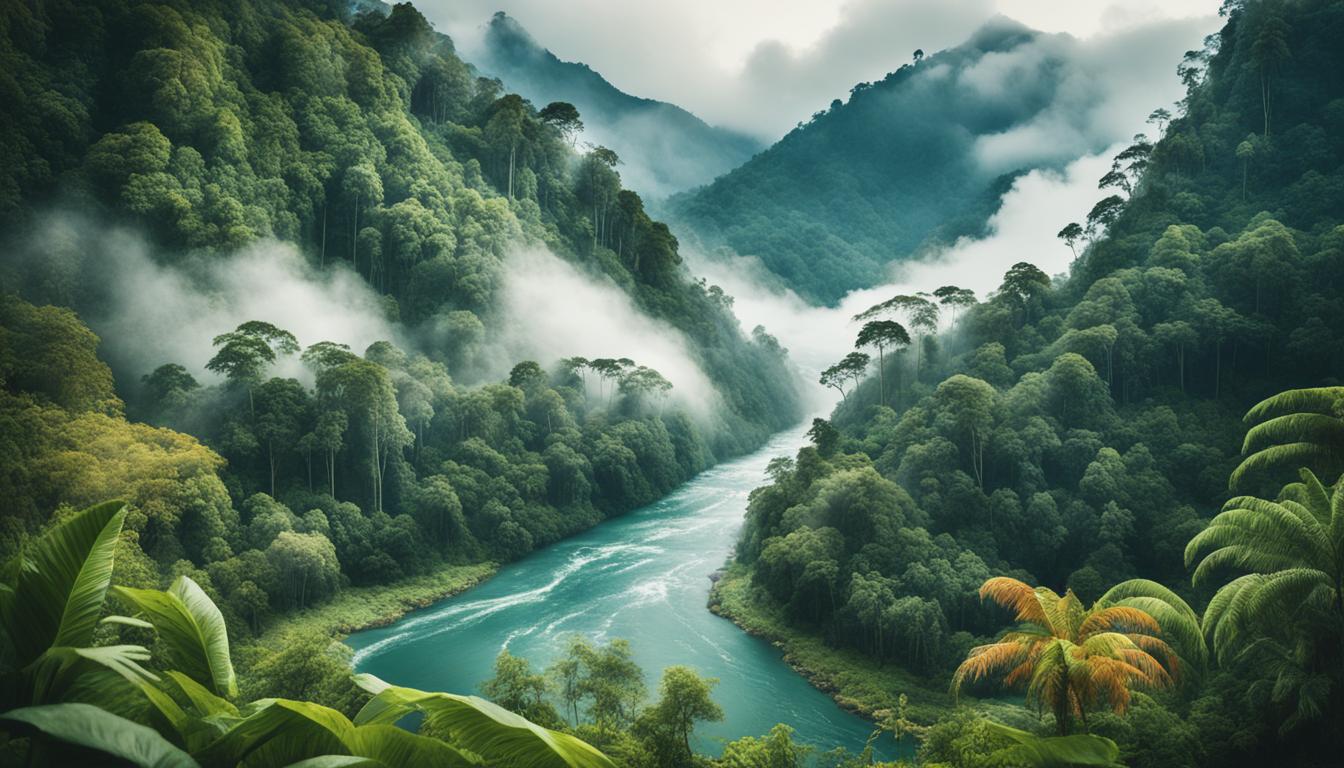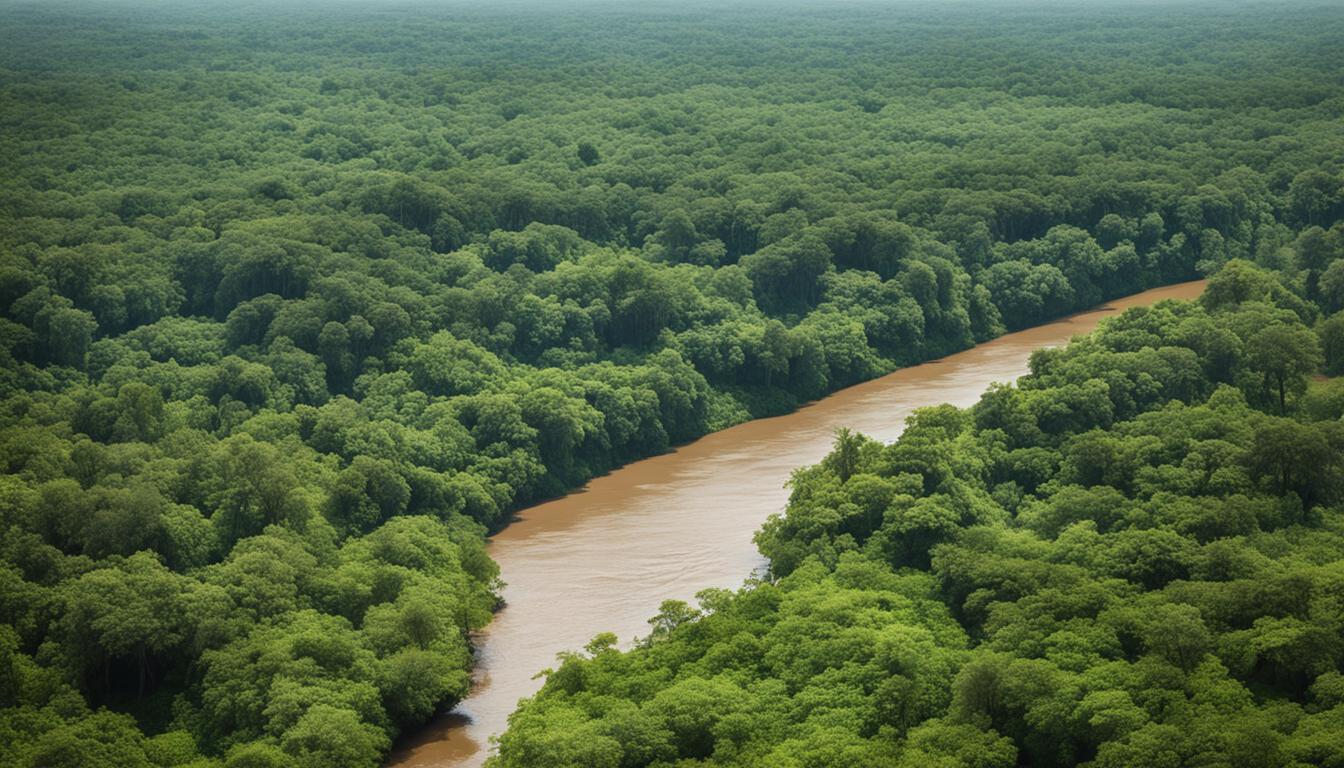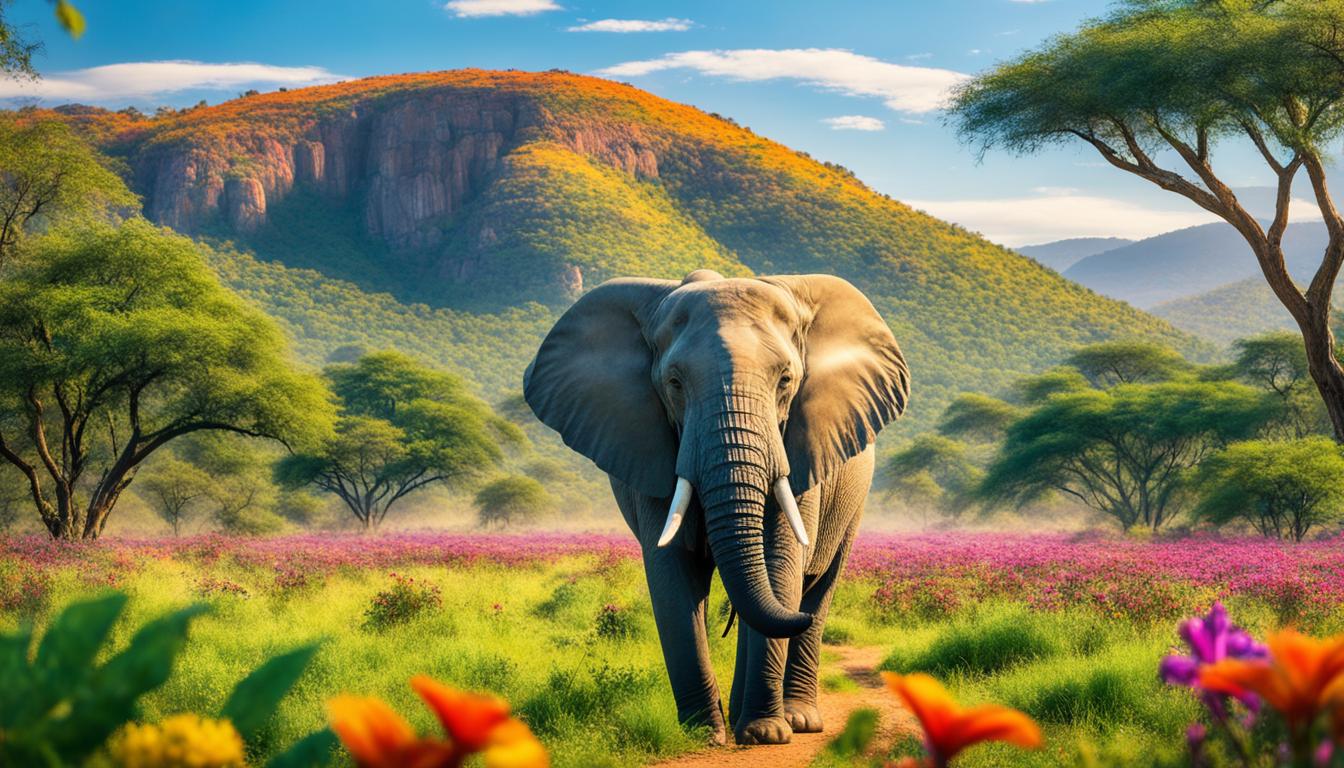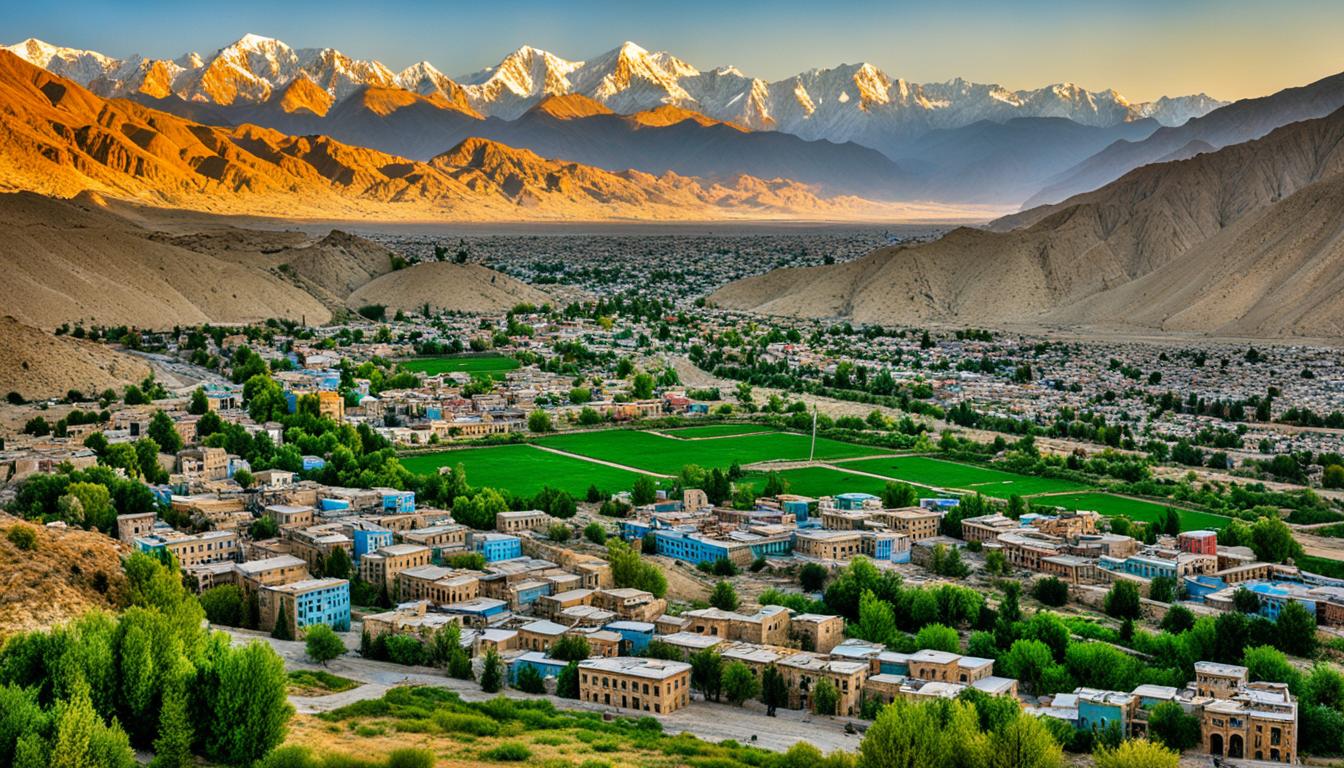Guinea Sacred Natural Sites and Biodiversity
Did you know that sacred natural sites (SNS) have been recognized as the oldest form of habitat protection in human history? These sites, found in various countries around the world, serve as sanctuaries for biodiversity and play a crucial role in conservation efforts.
In Guinea, a West African country known for its rich natural landscapes, sacred natural sites hold immense cultural, ecological, and biological significance. These sites have been preserved and protected by indigenous communities for centuries, showcasing the remarkable connection between nature and spirituality.
Key Takeaways
- Sacred natural sites are the oldest form of habitat protection in human history.
- Guinea’s sacred natural sites contribute significantly to biodiversity conservation.
- The conservation practices of Guinea’s indigenous communities play a vital role in safeguarding these sites.
- Guinea’s sacred natural sites encompass diverse ecosystems and support unique species.
- Urgent action is needed to address threats and protect Guinea’s sacred natural sites for future generations.
The Importance of Sacred Natural Sites in Conservation Efforts
Sacred natural sites (SNS) play a crucial role in biodiversity conservation, acting as an important complement to protected areas in nature conservation efforts. While protected areas are vital for safeguarding biodiversity, they have limitations in effectively halting the ongoing biodiversity crisis. SNS have been recognized as a form of Other Effective Area-Based Conservation Measures (OECMs) that contribute to conservation as a by-product of other management goals.
SNS have been protected for centuries, with some sites even pre-dating modern protected areas. These sacred sites have proven to have the same or higher levels of species richness compared to their surroundings. They act as refugia for endemic and threatened species, providing a safe haven for biodiversity.
Research on the ecological significance of SNS demonstrates that these sites are home to diverse plant and animal species, harboring unique ecological communities. They often contain rare and endangered species, making them key hotspots for conservation and protection.
It is important to acknowledge the cultural value of SNS in addition to their ecological significance. These sites hold deep spiritual and cultural meaning for local communities, who have been custodians of these lands for generations. By recognizing the importance of SNS and integrating their conservation into broader conservation efforts, we can ensure the long-term preservation of Guinea’s natural and cultural heritage.
The Conservation Practices of Guinea’s Indigenous Communities
Guinea’s indigenous communities play a vital role in the conservation of sacred natural sites. These communities have a deep connection to their natural surroundings through their culture and religious beliefs. They have traditional custodians who are responsible for conserving and managing the sites.
The conservation practices of Guinea’s indigenous communities are rooted in their rich cultural heritage and traditional knowledge. These communities have a profound understanding of the ecological significance of sacred natural sites and the importance of preserving them for future generations. They recognize that these sites are not just physical spaces, but also hold spiritual and symbolic value.
The management of sacred natural sites is guided by local myths, stories, and taboos that regulate access and resource use. These cultural practices ensure that the sites remain protected and the biodiversity within them thrives. The indigenous communities play a crucial role in enforcing these rules and ensuring that the sites are not disturbed or exploited.
“Our sacred natural sites are the lifeblood of our communities. They are our connection to the land, to our ancestors, and to the spirits that guide us. We have a responsibility to protect and preserve them for future generations.”
From a young age, community members are taught the importance of these sacred natural sites and the need to uphold the conservation practices passed down through generations. They participate in rituals and ceremonies at these sites, making offerings and performing traditional customs that reinforce the relationship between the community and nature.
The Role of Traditional Ecological Knowledge
Guinea’s indigenous communities have a wealth of traditional ecological knowledge that informs their conservation practices. This knowledge is deeply intertwined with their spiritual beliefs and cultural practices. They have a profound understanding of the local ecosystems, the behavior of plant and animal species, and the interconnectedness of all living beings.
This traditional ecological knowledge is applied in various ways, such as sustainable resource use, fire management, and the identification and protection of sacred species. It is based on centuries of observation, experimentation, and adaptation to the local environment.
The Challenges Faced by Indigenous Communities
Despite their efforts, Guinea’s indigenous communities face numerous challenges in their conservation practices. Modernization, external influences, and encroachment on their traditional lands threaten the transmission of local knowledge and practices. The allure of urban areas leads to a loss of traditional values and a disconnection from the natural world.
Additionally, climate change poses significant threats to the sacred natural sites and the biodiversity within them. Rising temperatures, changing rainfall patterns, and increased frequency of extreme weather events affect the fragile ecosystems and disrupt the delicate balance maintained by indigenous communities.
However, despite these challenges, Guinea’s indigenous communities remain resilient in their commitment to the conservation of sacred natural sites. They continue to fight for the recognition of their rights, the protection of their ancestral lands, and the preservation of their cultural heritage.
| Challenges | Conservation Practices |
|---|---|
| Modernization and external influences | Preserving traditional practices, raising awareness, and empowering indigenous communities |
| Climate change | Implementing adaptive measures, supporting sustainable resource management, and integrating traditional ecological knowledge with scientific understanding |
The conservation practices of Guinea’s indigenous communities are crucial in maintaining the ecological balance and preserving the cultural heritage of sacred natural sites. Collaborative efforts between indigenous communities, government agencies, NGOs, and international organizations are essential to address the challenges faced and ensure the long-term conservation of these valuable sites.
Ecology and Biodiversity of Guinea’s Sacred Natural Sites
Guinea’s sacred natural sites encompass a diverse range of ecosystems, including savannas, arid and semi-arid forests, mangroves, and rice cultures. These sites, rich in biodiversity, offer a greater abundance of edible and medicinal plants compared to their surrounding areas. The preservation of these sites is crucial for maintaining the region’s unique ecological and biological diversity.
Within Guinea’s sacred natural sites, various animal species find a haven for survival. The West African Manatee, the Green Turtle, and the Nile Crocodile are just a few examples of the remarkable wildlife that call these sites their home. These sites provide essential habitats for these species and contribute to regional biodiversity. The interconnectedness of these ecosystems ensures the sustainability and well-being of the fauna and flora within them.
“The biodiversity found within Guinea’s sacred natural sites is a testament to the intricate ecological balance that has been preserved for generations. These sites exemplify the importance of protecting and valuing our natural heritage.”
It is not just the presence of various species that makes these sacred sites valuable. The ecological diversity also includes unique habitats and natural processes that contribute to the overall health of the ecosystems. The interconnected web of life within these sites supports numerous ecological functions, such as nutrient cycling, soil formation, and water filtration. Preserving these habitats ensures the conservation of crucial ecosystem services that benefit both nature and humanity.
Additionally, Guinea’s sacred natural sites serve as refugia for many endemic and threatened species. These sites offer a safe haven for rare and specialized organisms, shielding them from threats such as habitat destruction and climate change. By protecting these sites, we safeguard the genetic diversity and evolutionary potential of these species, ensuring their continued existence for generations to come.
Biodiversity Highlights of Guinea’s Sacred Natural Sites
| Ecosystem Type | Biodiversity Highlights |
|---|---|
| Savannas | Rich in diverse grasses, flowering plants, and herbivores |
| Arid and Semi-arid Forests | Home to unique plant species and specialized animal adaptations |
| Mangroves | Support a diverse range of marine and coastal species |
| Rice Cultures | Provide vital habitat for aquatic species and migratory birds |
Guinea’s sacred natural sites are not only a testament to the country’s rich cultural heritage but also to its ecological wealth. These sites offer a glimpse into the interconnectedness of life and the resilience of nature. By recognizing the importance of these sites and implementing effective conservation strategies, we can ensure the preservation of Guinea’s unique ecological and biological diversity.
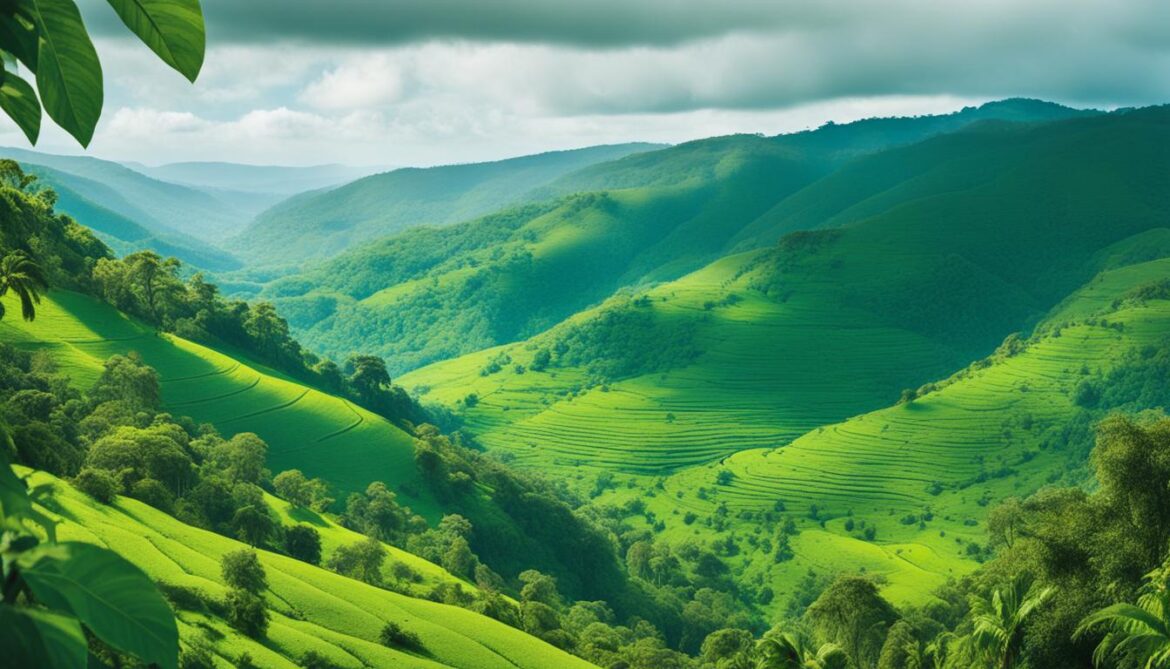
Threats to Guinea’s Sacred Natural Sites
Guinea’s sacred natural sites face numerous threats to their conservation. These sites, which hold cultural and ecological significance, are at risk from various factors.
Climate Change and Rising Sea Levels
The impact of climate change poses significant risks to Guinea’s coastal sacred lands. Rising sea levels threaten to erode these sites and disrupt the delicate balance of ecosystems that exist there.
Modernization and External Influence
The rapid modernization driven by external groups poses a threat to the transmission of local knowledge and traditions associated with Guinea’s sacred natural sites. The allure of urban areas can lead young community members to abandon traditional practices, endangering the preservation of these culturally significant sites.
Intensive Fishing by Outside Fishermen
Intensive fishing practices by outside fishermen contribute to the depletion of marine resources surrounding Guinea’s sacred natural sites. This exploitation not only affects the biodiversity of these areas but also undermines their ecological balance.
Urgent action is needed to mitigate these threats and protect the cultural and ecological values of Guinea’s sacred natural sites. By implementing effective conservation measures and raising awareness about the importance of these sites, we can safeguard the rich cultural heritage and unique ecosystems found within them.
Conservation Efforts and Challenges in Guinea’s Sacred Natural Sites
Conservation efforts in Guinea’s sacred natural sites have primarily focused on regulating fisheries and protecting biodiversity in general. While these efforts have been valuable, it is crucial to implement more specific measures that ensure the long-term conservation of these unique sites.
Blanket recognition and mapping of all sacred natural sites, whether located inside or outside protected areas, is of utmost importance for juridical protection. This comprehensive approach will help safeguard these sites from encroachment and promote their ecological significance.
Another crucial aspect is empowering community action and increasing awareness. Community involvement is central to the success of conservation efforts in Guinea’s sacred natural sites. By supporting and partnering with local communities, through scientific studies, NGOs, and educational programs, we can harness their traditional knowledge and practices to address the challenges faced by these sites.
Furthermore, it is essential to integrate the protection of sacred natural sites into national policy and law. By recognizing their significance and implementing legal measures that prioritize their conservation, Guinea can ensure the long-term preservation of these invaluable natural and cultural heritage sites.
Challenges in Conservation
Despite the ongoing efforts, several challenges persist in the conservation of Guinea’s sacred natural sites. These challenges include:
- Climate change: The impact of climate change, such as rising sea levels, poses a significant threat to coastal sacred lands, putting these sites at risk of irreversible damage.
- Modernization: The rapid modernization of the region, driven by external influences, can lead to the loss of traditional practices and the erosion of local knowledge and traditions.
- Displacement: Young community members are often attracted to urban areas, resulting in a loss of active community involvement and traditional conservation practices.
- External pressures: Intensive fishing by outside fishermen can deplete marine resources, impacting the delicate balance of these ecosystems and the communities that rely on them.
Addressing these challenges requires urgent action and a collaborative approach. By engaging with local communities, international organizations, and policymakers, we can develop strategies and implement measures that protect Guinea’s sacred natural sites for future generations.

Challenges in Conservation Efforts
| Challenges | Impact |
|---|---|
| Climate change | Puts coastal sacred lands at risk |
| Modernization | Threatens traditional practices and local knowledge |
| Displacement | Reduces community involvement and traditional conservation practices |
| External pressures | Depletion of marine resources |
The Role of International Organizations and Local Communities in Conservation
International organizations such as the FIBA and UNESCO have played a vital role in supporting research and raising awareness about the importance of Guinea’s sacred natural sites. By providing funding and technical expertise, these organizations have facilitated scientific studies and promoted the integration of traditional knowledge and practices into conservation efforts.
However, the primary custodians of Guinea’s sacred natural sites are the local communities themselves. Through their deep connection to the land and their long-standing traditions, these communities have thrived in preserving and protecting these sites for generations.
Recognizing the significance of local involvement, efforts have been made to empower communities in site management and decision-making processes. This participatory approach ensures that the unique perspectives and needs of the local population are considered, fostering a sense of ownership and responsibility.
In addition to participatory approaches, awareness-raising activities have been essential in engaging both local communities and the wider public. By organizing educational campaigns and workshops, NGOs and scientists have worked collaboratively to promote the value of Guinea’s sacred natural sites and the importance of their conservation.
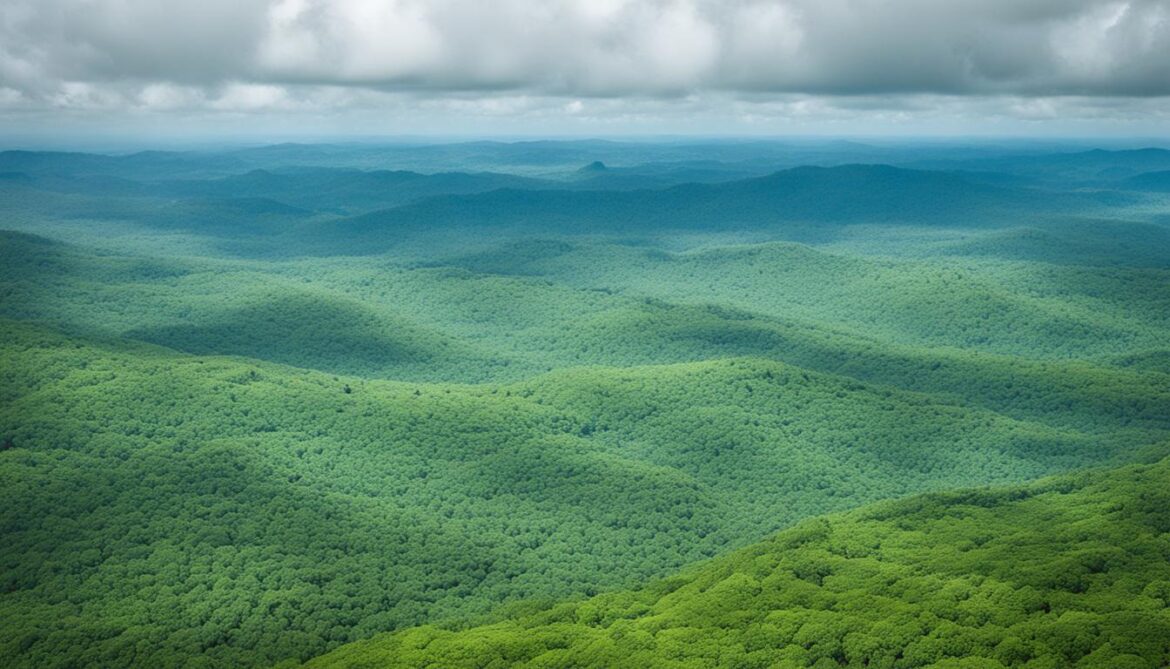
Collaborative efforts between international organizations, local communities, scientists, and NGOs are crucial for the long-term conservation of Guinea’s sacred natural sites. By combining traditional knowledge with scientific expertise, we can develop effective strategies that balance environmental protection, cultural preservation, and sustainable development.
These collaborative efforts have also led to the development of specific laws and policies that recognize and protect the cultural and ecological values of Guinea’s sacred natural sites. By integrating traditional practices into national legislation, policymakers can ensure the sustainable management of these sites for future generations.
Benefits of International and Local Collaboration
The role of international organizations and local communities in conservation extends beyond the immediate preservation of sacred natural sites. Through collaboration, the following benefits can be realized:
- Enhanced research: International organizations facilitate scientific studies and support capacity-building initiatives, allowing for a deeper understanding of the ecological and cultural importance of these sites.
- Inclusive decision-making: Engaging local communities in conservation efforts ensures that their knowledge, perspectives, and needs are taken into account, promoting a sense of ownership and sustainability.
- Increased awareness and advocacy: By working together, international organizations and local communities can amplify their voices and advocate for the protection of Guinea’s sacred natural sites on a global scale.
As we continue to navigate the challenges of environmental conservation, the collaboration between international organizations and local communities serves as a model for achieving sustainable and inclusive solutions. By valuing traditional knowledge, empowering local communities, and fostering partnerships, we can safeguard the invaluable cultural and ecological heritage of Guinea’s sacred natural sites for generations to come.
Policy, Law, and Future Directions for Sacred Natural Sites in Guinea
Guinea has recognized the importance of sacred natural sites in its national legislation. The national act on protected areas acknowledges sacred sites as sites for religious practice and ensures their natural state cannot be altered. Access to these sites is restricted according to local community regulations, and the law on land tenure protects traditional residents’ right of access.
However, enforcement and integration of these laws with other policy measures remain a challenge. There is a need to strengthen policy and law enforcement to ensure the effective conservation of Guinea’s sacred natural sites. Collaborations across sectors, including government institutions, NGOs, and local communities, are crucial for the successful implementation of conservation efforts.
It is important to address the specific needs of sacred natural sites in Guinea. This includes developing guidelines for sustainable resource use and defining management practices that respect their cultural and ecological significance. By incorporating the knowledge and perspectives of local communities, policy and law can be better tailored to meet the unique challenges and opportunities of sacred natural site conservation.
Future Directions for Conservation
In order to ensure the long-term conservation of Guinea’s sacred natural sites, the following steps are crucial:
- Strengthen policy and law enforcement mechanisms to protect sacred natural sites.
- Promote intersectoral collaborations to integrate conservation efforts with other policy measures.
- Implement participatory approaches that actively involve local communities in site management and decision-making processes.
- Develop guidelines for sustainable resource use and management practices that respect the cultural and ecological significance of sacred natural sites.
- Facilitate scientific research and monitoring initiatives to enhance our understanding of the biodiversity and ecological dynamics of these sites.
By prioritizing the conservation of sacred natural sites and taking these steps, Guinea can preserve its rich natural and cultural heritage for future generations.
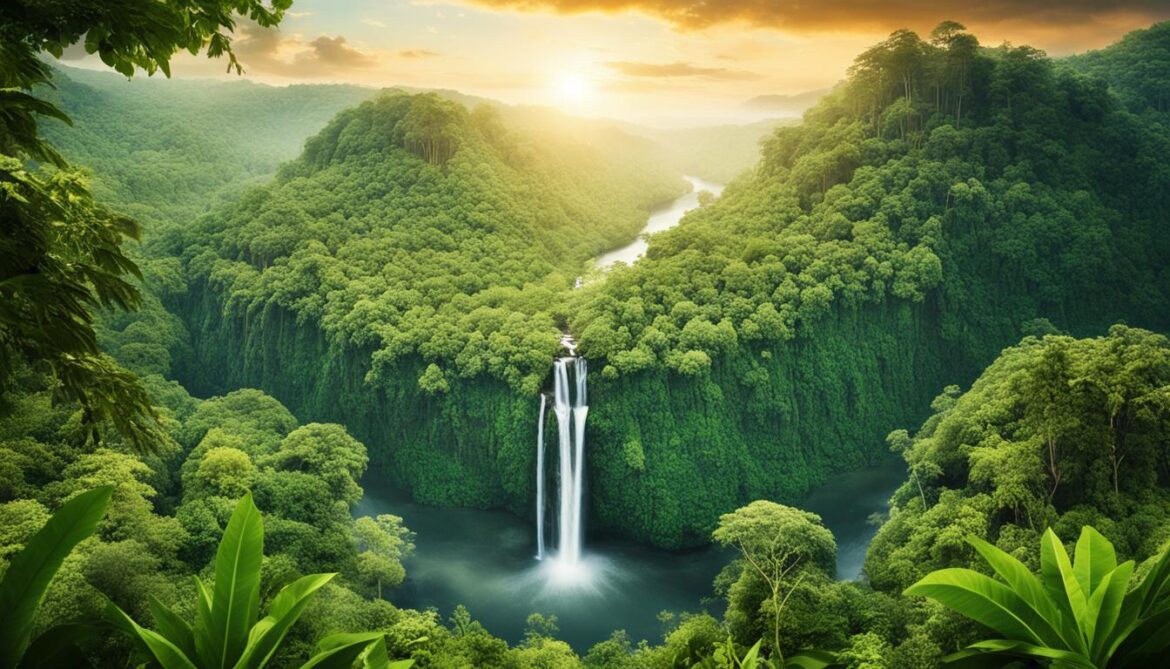
| Challenges | Solutions |
|---|---|
| Enforcement and integration of laws | Strengthen policy and law enforcement mechanisms |
| Inclusion of local community perspectives | Facilitate participatory approaches and engage local communities |
| Sustainable resource use | Develop guidelines for sustainable management practices |
| Research and monitoring | Support scientific research and monitoring initiatives |
Conclusion
The connection between Guinea’s sacred natural sites and biodiversity conservation is evident. These sites play a significant role in preserving biodiversity, maintaining cultural traditions, and protecting unique ecosystems. However, challenges such as climate change, modernization, and limited legal protection pose threats to their conservation.
It is crucial for international organizations, local communities, and policymakers to collaborate and take action to ensure the long-term conservation of Guinea’s sacred natural sites. By recognizing the importance of these sites and implementing effective conservation measures, Guinea can safeguard its natural and cultural heritage for future generations.




